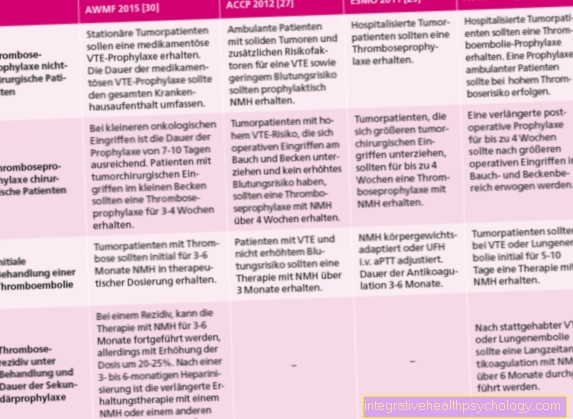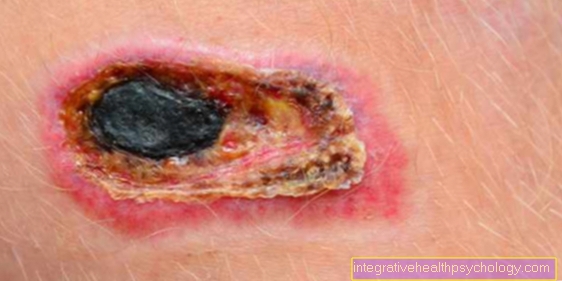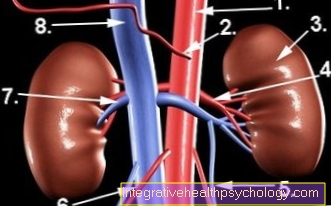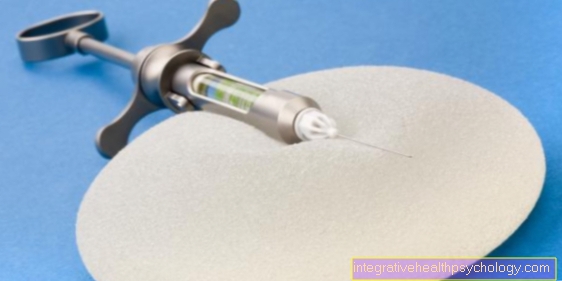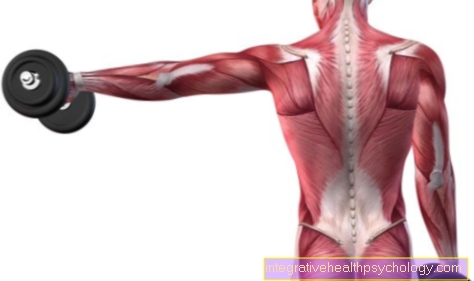Capsule tear at the ankle
definition
The ankle is exposed to high weight loads and is therefore prone to injuries and strong forces. A rupture of the joint capsule is a very painful clinical picture that may still cause movement restrictions even after a long time.

causes
The primary cause of a capsule rupture is a sudden strong force, triggered by strong pressure or tensile loads, but also by blows or bumps on the joint. These acts of violence can occur in sport, during heavy physical work, but also in everyday life. A typical injury in sports and everyday life is the twisting of the foot. The ligament involved is also part of the outer ankle joint capsule and can also damage the capsule if it tears.
Sports that are particularly stressful for the ankle are basketball, football or jumping sports. Hiking on uneven paths can also pose a risk to the ankle. In some cases, the connective tissue of the ankle joint capsule may have been damaged by other previous illnesses. Connective tissue weaknesses can be genetic or acquired. An extreme lack of movement, for example after an injury to the foot or leg, can make the capsule more prone to injuries.
Symptoms
The main symptom of an ankle capsular tear is pain. This occurs immediately with the injury and is difficult to locate, dull and throbbing in the ankle area. Shortly afterwards, swelling and redness will develop in the area of the ankles, indicating the bruise. The foot feels very warm. The bruise turns blue after a few days, and finally green and yellow after a few weeks, which indicates that it is breaking down. The dull, throbbing pain develops after a few days into an easily localizable, stabbing pain when moving. In rare cases, the foot can be misaligned in the ankle. This strongly suggests bony involvement of the injury.
Pain after a capsule tear at the ankle
The pain is the main symptom of the torn capsule on the ankle. It often persists over the entire duration of the illness and can also persist chronically beyond that. When the capsule ruptures, damage occurs to both leaves of the joint capsule, but also to the joint cartilage and the bone itself. These structures and especially the inner layer of the joint capsule are extremely sensitive to pain.
After a few minutes, a swelling also forms, which in turn presses on the pain-sensitive structures. In the following weeks, the pain develops into a sharp and movement-dependent pain, so the most important measure is to immobilize the ankle. The pain can be reduced with pain medication so that movement can be increased more easily after about 2 weeks.
Read more about this at Pain in the ankle
swelling
Since a capsule tear is an extensive injury to the connective tissue supplied with blood, it also always leads to an injury to smaller blood vessels. The blood vessels themselves can regenerate without any problems, but minor bleeding in the joint can occur immediately after the injury, which causes uncomfortable swelling. Pronounced swelling significantly restricts the movement of the ankle, worsens existing pain and can have a negative effect on the healing time. In order to stop the bleeding from the small vessels early after the trauma, the foot should be elevated, compressed and cooled as soon as possible.
Appointment with ?

I would be happy to advise you!
Who am I?
My name is I am a specialist in orthopedics and the founder of .
Various television programs and print media report regularly about my work. On HR television you can see me every 6 weeks live on "Hallo Hessen".
But now enough is indicated ;-)
In order to be able to treat successfully in orthopedics, a thorough examination, diagnosis and a medical history are required.
In our very economic world in particular, there is too little time to thoroughly grasp the complex diseases of orthopedics and thus initiate targeted treatment.
I don't want to join the ranks of "quick knife pullers".
The aim of any treatment is treatment without surgery.
Which therapy achieves the best results in the long term can only be determined after looking at all of the information (Examination, X-ray, ultrasound, MRI, etc.) be assessed.
You will find me:
- - orthopedic surgeons
14
You can make an appointment here.
Unfortunately, it is currently only possible to make an appointment with private health insurers. I hope for your understanding!
For more information about myself, see - Orthopedists.
Bone splintering when the capsule ruptures at the ankle
The upper ankle has to withstand a large part of the body weight and strong movements of the lower legs and feet. In order to stabilize the joint sufficiently, it is surrounded by many tight ligaments that are also involved in the outer shell of the joint capsule. The ligaments attach to the ankles of the lower leg bones and the foot. In the event of severe tensile loads as part of an accident, the ligaments can tear and even lead to bone splintering. The outer ankle is most frequently affected in an ankle trauma. Bone involvement must be ruled out with an X-ray, as this results in a significantly higher instability in the joint. Therapy also changes with a bone fracture. Here, the bone and the affected ligament often have to be surgically fixed again.
diagnosis
In most cases, the diagnosis of a torn capsule on the ankle is only made on the basis of a detailed medical history and physical examination. Severe swelling after an accident, which is accompanied by pain and restricted mobility, indicates an injury to the ligaments and structures of the joint capsule.
Nevertheless, an X-ray should also be made in the case of serious injuries, as there is an increased risk of bone involvement in the ankle joint. In contrast to other joints, involvement of bone fragments of the lower leg often results in surgery. Under certain circumstances, an MRI image can also be made to better assess the injury.
MRI of the ankle
The MRI examination is only necessary in rare cases.
A clinical examination and an X-ray check for involvement of the bone are often sufficient to make the diagnosis of a capsular tear.
The MRI can display soft tissues in particular in high resolution and is therefore well suited to assessing capsule damage, swellings, torn ligaments and many other injuries to the soft tissues of the ankle.
However, it is a rather complex and expensive diagnostic procedure that in most cases does not result in a change in therapy and is therefore superfluous. In the case of long-standing complaints, the MRI examination can provide important information about undetected damage to the ligamentous apparatus of the ankle.
You can find further information under our topic: MRI of the ankle
treatment
The most important part of the treatment takes place within the first two days after the accident. To reduce the healing time, pain and swelling, immobilization, cooling, compression and elevation of the foot should begin immediately. These measures allow minor bleeding to stop earlier, which reduces swelling. Immobilization can be performed at the ankle using splints, bandages and tapes.
In the following weeks, rest and immobilization are the most important measures of treatment. The swelling takes time to be absorbed and the capsule rupture can take several weeks to heal. In order to alleviate the pain and to enable a slow build-up of muscles and movement, sufficient pain medication should be taken.
Tape bandage
The ankle is a strong joint that carries a lot of body weight. In the event of injuries such as a capsule tear, it should be protected and immobilized, which is only partially possible with a tape bandage. Rigid and elastic tape bandages are used. They can be attached to the ankle with the guidance of a doctor or physical therapist and splinted the joint guidance and movements.
A rigid tape dressing has significantly stronger shining effects. The effects of the tape are to carry out movements more consciously, to prevent rapid movements and overstretching in the joint and to promote the muscle activity of the joint during movements. A tape dressing after a capsule rupture is particularly useful after a few weeks of healing in order to slowly and consciously allow and build up movements again.
Read more about taping on our website Taping the ankle
rail
There are various splints for the ankle that can be used primarily in the early treatment of the capsular tear. A splint is rigid and can therefore immobilize the joint in the event of an acute capsular tear and prevent movement. Many rails can be adjusted to allow certain movements. As a result, both the initial rest and a slow build-up of movement can be carried out in a controlled manner with the splint.
Ankle bandage
The bandage is another therapy option for immobilizing the ankle joint. In most cases, bandages are made of an elastic, soft material. Your main tasks are immobilization, slowing down of the movements and the awareness of the muscles and individual movements in the joint. Overall, the bandage results in significantly less immobilization than a splint or a rigid tape dressing. Therefore, if the capsule tears, the bandage should only be used after a few weeks for further therapy or for the prophylaxis of renewed injuries.
Read more about this on our website Ankle bandage
When is an operation necessary?
A capsular tear rarely requires surgery. As a rule, the capsule heals on its own, so that a complete restoration of movement is possible. However, if there is bone involvement, surgery may have to be performed. At the ankle, the joint capsule is formed, among other things, by various ligaments and muscles that are involved in movements of the lower leg and foot. If the ligaments are subjected to high tensile loads, important parts of the bone, which are responsible for stability in the ankle, may splinter. In many cases, these have to be surgically fixed with screws or plates. The dreaded ankle joint fracture, a fracture of the fibula, also requires extensive surgery to ensure stability.
Duration of healing
The healing time can vary and is difficult to estimate. The extent of the injury can vary widely and thus influence the symptoms, the therapy and the healing time. A capsule rupture can be a very protracted clinical picture, as the healing of the connective tissue only progresses slowly and full mobility of the joint can often only be achieved after months.
A slight tear in the capsule can be painless within a few days. However, if the joint capsule has a complex rupture, symptoms can last for weeks. A complete healing can often only be spoken of after 2-3 months. Bone involvement can also prolong the disease. Often surgical therapies have to be carried out, which result in lengthy rehabilitation. In rare cases, the capsule rupture can be the basis for chronic complaints and diseases of the joint.
Length of incapacity for work
The duration of the incapacity for work depends on the personal well-being and the restriction in the workplace caused by the injury. In most cases, a 1-2 week sick leave is first given to complete the acute treatment and reduce the pain. It should also be possible to cope with everyday life despite the injury to the ankle.
Office work can often be resumed after these two weeks, as work is not restricted by the injury. However, pronounced pain can be a hindrance. In many cases, physical work has to be paused for significantly longer. The activity should only be started again when there is freedom from pain and unrestricted movement and professional practice. The sick leave can initially be issued by a doctor without any salary restrictions for 6 weeks. In some cases, physically demanding occupations require reintegration measures, in which the work is gradually increased again after the injury.
What can the long-term consequences be?
Capsule tears can be very tedious despite conservative or surgical therapy. In the end, however, complete freedom from pain and unrestricted joint function are very likely. For many of those affected, there may be restrictions on stretching and flexing movements in the ankle for longer periods of time. Consistent physiotherapy can prevent movement restrictions in the healing phase.
The capsule rupture can cause unnoticed damage to the bones and cartilage of the joint. These often do not cause any discomfort and can cause wear on the joint for years. After many years, osteoarthritis can become painful due to a capsule rupture on the ankle. Osteoarthritis is a typical and chronic long-term consequence of joint injuries.











